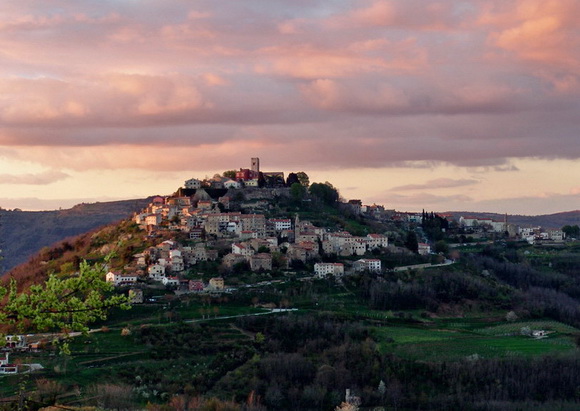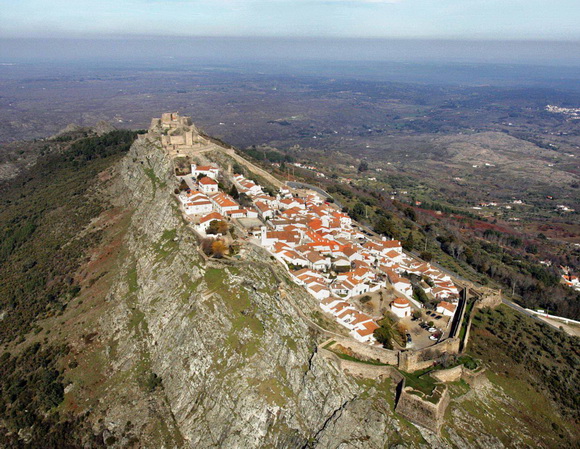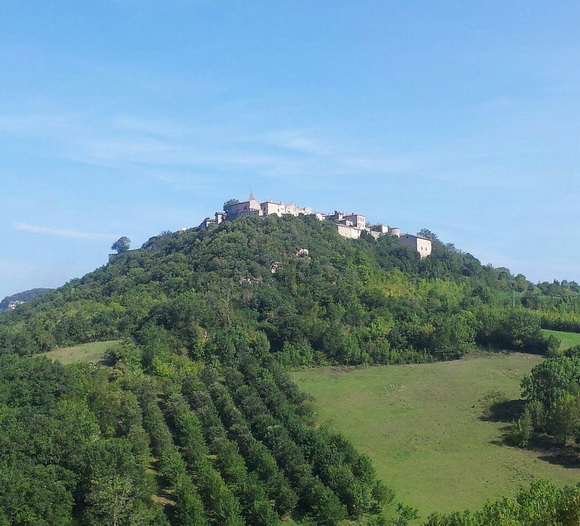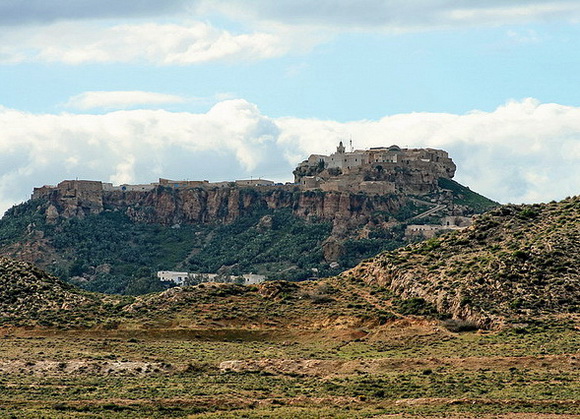1. Èze, France
Èze is a village in the Alpes-Maritimes department in southeastern France, not far from the city of Nice. Traditionally, the territory of the Principality of Monaco was considered to begin in the Èze village (outskirts of Nice), running along the Mediterranean coast to Menton, on the present Italian border.
Èze, renowned tourist site on the French Riviera, is famous worldwide for the view of the sea from its hill top. Its Jardin botanique d'Èze is known for its collection of cacti and succulents, as well as its panoramic views.
The small medieval village is famous for its beauty and charm. Its many shops, art galleries, hotels and restaurants attract a large number of tourists and honeymooners.
....
As a result Èze has become a "museum village", few local residents live here. From Èze there are gorgeous views of the Mediterranean Sea. [link, map]
2. Castelluccio, Italy
Castelluccio is a village in Umbria, in the Apennine Mountains of central Italy. It is located about 28 km (17.4mi) from the town of Norcia. According to the 2001 census, it had close to 150 inhabitants.
The village lies at 1452 m (4760ft), making it the highest settlement in the Apennines. It lies above the "Great Plain" (Piano Grande - 1270m or 4166ft), next to the Monti Sibillini National Park.
Rain and meltwater accumulate on the surface of the plain, which is made of largely impermeable sediments. The greenish ditches drain the water towards openings called Ponors, which are part of the karstic underground drainage system. If the karst drainage is blocked for any reason, water backs up and turns the plain into a temporary lake.
The fields on the slopes below the village are cultivated; the town is known for its excellentlentils. In springtime the nature of the fields is in lavish color, with red poppies and yellow rapeseed. The plains grassland is ideal for sheep husbandry. There is a lot of ski- and trekking tourism. [link, map]
3. Calcata, Italy
Calcata is a town in the Province of Viterbo in the Italian region Latium, located 47 km (30mi) north of Rome by car, overlooking the valley of Treja river.
In the 1930s, the hill towns's fortified historic center was condemned by the government for fear that the volcanic cliffs the ancient community was built upon would collapse. Local residents moved to nearby Calcata Nuova.
In the 1960s, the emptied historical centre began to be repopulated by artists and hippies who squatted in its medieval stone and masonry structures. Many of the squatters eventually purchased their homes, the government reversed its condemnation order, and the residents of what had become an artistic community began restoring the ancient town.
This trend has continued. Today the town has a thriving artistic community described in the New York Times as what "may be the grooviest village in Italy, home to a wacky community of about 100 inhabitants. [link, map]
4. Motovun, Croatia
Motovun is a village in central Istria, Croatia. The population of the village itself is 531, with a total of 983 residents in the municipality (2001).
Motovun is a medieval town that grew up on the site of an ancient city called Kastelijer. It is situated on a hill 270 m (886 ft) above sea level with houses scattered all over the hill. On the inner walls are several coats-of-arms of different Motovun ruling families and two gravestones of Roman inhabitants (dating from the 1st century).
The river Mirna flows below the hill and on the other side of the river there is the famous Motovun forest, an area of about 10 sq km (3.8sq mi) in the valley of the river Mirna, of which 280 hectares (690 acres) is specially protected. This area differs completely not only from the nearby forests, but also from those of the entire surrounding karst region because of its wild life, oist soil and rich-with-prized-black-and-white truffles, which grows successfully there.
Motovun's ground plan is depicted on the reverse of the Croatian 10 kuna banknote, issued in 1993, 1995, 2001 and 2004. [link, map]
5. Calitri, Italy
Calitri is a town and commune of 5,292 inhabitants situated in the province of Avellino, Campania, Italy. It is approximately 530 metres (1740ft) above sea level so even on the hottest day there is generally a breeze.
The Antico Borgo is in the oldest section of the town – the centro storico – at the top of which are the remains of a castle which predates the 12th century. The Borgo itself is a labyrinth of historic houses which have, over the centuries, been built into the hillside. Stone and marble stairs – frequently under old stone arches – connect the streets. [link, map]
6. Marvão, Portugal
Marvão is a spectacular medieval walled village perched at 900 metres (2950 ft) on a rocky crag called the Serra de Marvao. The narrow cobbled streets lined with whitewashed houses many with decorative doors and windows from the 15th century, wind their way up to one of the best preserved castle in Portugal dating from the 13th century.
The views from the castle are truly breathtaking looking out over wild rocky landscape towards Spain and the Serra da Estrela mountains in Portugal, which are often snow capped in winter. At dawn, in the evening or when the mists close in Marvao becomes almost eerie as it rises up to touch the sky. This is a very special place. [link, map]7. Tizourgane Kasbah, Morocco
Tizourgane Kasbah is a beautiful and well preserved village fortress on rocks. You can find this complex in South Morocco in the Anti Atlas mountains.
This village was built eight centuries ago, as a shelter for the farmers of the civil wars. Today in Tizourgane Kasbah lives only five families. The land surrounding is not cultivable any more, alone some goats graze there and the cactus and almond trees flood the landscape. [map]
8. Peillon, France
Peillon is one of several perched villages in the Alpes-Maritimes department, just a few kilometres north of Monaco and the Cote d'Azur but at almost 400 metres (1300 ft) altitude.
It is in a startling location, on top of a cliff and with higher mountains rising behind the village - and one of the most attractive villages to be found in the area.
The view up to the village as you approach along the narrow road is also one of the highlights, creating a very dramatic contrast with the Riviera coast to the south that you have only just left behind you.
The village is one of the most successful in the region at offering a fascinating insight into how life might have been 500 years ago for inhabitants of this remote location, and there are numerous features of historical interest and beauty to discover as you explore. [link, map]
9. Trevi, Italy
Trevi is an ancient town and comune in Umbria, Italy. Most of the town, densely inhabited and of decidedly medieval aspect, lies on sharply sloping terrain, only the very center being more or less flat.
It commands one of the best views in Umbria, extending over 50 km (30 mi) in most westerly directions. Trevi is served by the main rail line from Rome to Ancona as well as the line from Florence to Rome via Perugia.
The hills in the surrounding area are an ideal terrain for the intensive and highly specialized cultivation of olive trees, that produce a very characteristic and highly prized oil. Finally, the mountains are clothed in meadows and forests, primarily deciduous.
The natural environment of the territory as a whole remains largely unspoiled, this despite being significantly populated for millennia. The mountainous area is now witnessing a considerable depopulation - as elsewhere in Italy, in the second half of the 20th century settlements at the highest elevations have been rapidly losing their inhabitants to the plains. [link, map]
10. Puycelci, France
Puycelci is a village in the Tarn department in southern France. It is a member of the Les Plus Beaux Villages de France ("The Most Beautiful Villages of France") association.
The name of "Puycelci", or "Puycelsi", comes from the Celtic "Celto Dun", a wooden fortress built on a hill, or oppidum, later transformed into "Podium Celsium" by the Romans.
The village itself was founded in the 10th century by Benedictine Monks. The first castle was dismantled after the Treaty of Meaux-Paris, in 1229, but the village remained a stronghold. Though it was besieged several times in the 13th and 14th century, it was reportedly never taken by force.
 |
| Puycelci surrounded by fog link |
Until the First World War, the village was quite prosperous, with a population of nearly 2,000 in 1830. Almost abandoned in the 1950s, it was since then restored by its inhabitants. [link,map]
11. Civita di Bagnoregio, Italy
Civita di Bagnoregio is a town in the Province of Viterbo in Central Italy, a frazione of the commune of Bagnoregio, 2 km (about 1 mile) west from it. It is about 145 km (90 mi) north of Rome. The town is noted for its striking position atop a plateau of friable volcanic tuff overlooking the Tiber river valley, in constant danger of destruction as its edges fall off, leaving the buildings built on the plateau to crumble. As of 2004, there are plans to reinforce the plateau with steel rods to prevent further geological damage.
The city is also much admired for its architecture, some spanning several hundred years. Civita di Bagnoregio owes much of its unaltered condition to its relative isolation: the town was able to withstand most intrusions of modernity as well as the destruction brought by two world wars. The population today varies from about 12 people in winter to over 100 in the summer.
The town was placed on the World Monuments Fund's 2006 Watch List of the 100 Most Endangered Sites, due to the threats it faces from erosion and unregulated tourism. [link,map]
12. Comares, Spain
Comares is a town and municipality in the province of Málaga, part of the autonomous community of Andalusia in southern Spain. The municipality is situated approximately 28 km (17.4 mi) from the provincial capital and 24 km (15 mi) from Vélez-Málaga.
 |
| Comares surrounded by fog link |
It is located in the foothills of the Montes de Málaga 703 meters (2300 ft) above sea level. Comares is one of the 31 villages that make up the comarca of Axarquía. It has a population of approximately 1,420 residents. The natives are called Moriscosos. [link, map]
13. Al Hajjarah, Yemen
Al Hajjarah is a village in Yemen. It is located in the Manakhah District of the Sana'a Governorate, in the Haraz Mountains.
Al Hajara is built upon a precipice, and is famous for the houses which are built onto the cliff faces. [link, map]14. Takrouna, Tunisia
Takrouna is a small village in the Tunisian Sahel region, located about six miles (10 km) west of Enfida, direction Zaghouan. It is built on a rock rising to 200 meters (650 ft) above sea level overlooking a surrounding plain, overlooking the Gulf of Hammamet and Sousse Hergla east, Jebel Zaghouan north and south of Kairouan plain.
The village is of Berber origin and its present name is most probably related to a tribe that migrated to Andalusia in the eighth century and given its name, Ta Kurunna, a mountainous region near Málaga.
Following the expulsion of the Moors in 1609, a family of immigrants would be installed in the village and gave it its name. Still living six families of Berber origin, living on agriculture, weaving of alfa and Berber rugs. [link, map]15. Bucchianico, Italy
Bucchianico is a town in the Province of Chieti in the Abruzzo region of Italy. The town is situated on a hill between the river valleys Alento and Bucchianico Forum, and has a view extending from the Maiella to 'Adriatico. Its territory is hilly, mainly arable, but with a significant presence of olive groves and vineyards, is profoundly affected by characteristic forms of erosion, gullies.
The climate is temperate hilly, with winter temperatures about 6°C (43°F) and summer at about 23.5°C (74°F) and relatively abundant rainfall, which are around 1000 mm and are mainly concentrated in late autumn. [link, map]



























.jpg)









+(1).jpg)









